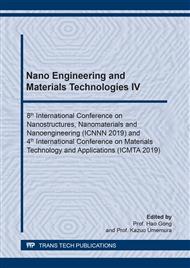p.161
p.168
p.173
p.177
p.183
p.191
p.197
p.204
p.209
The Effect of Different Extracting Conditions on the Antibacterial Activity of Moringa oleifera Lam. Leaves Extract for the Development of Antibacterial Meat Tray
Abstract:
Moringa oleifera Lam. leaves is the popular plant which provides an impressive range of medicinal uses because of major phytoconstituents in leaves. Such phytoconstituents contents are highly affected by extraction conditions. Therefore, the effects of different solvent extraction, temperature and time of extraction on antibacterial activity and total phenolic contents (TPC) of M.oleifera Lam. leaves extract were determined. The antibacterial result of all extract against E.coli showed no inhibition zone, while ethanolic extracts significantly affected to S.aureus inhibition that increasing concentration of ethanol provided an increasing in inhibition zone and decreasing MIC value from 5 to 1.25 mg/ml. Low-temperature extraction (40°C) was indicated as the optimum temperature which led to high antibacterial activity. The effect of extraction time was directly related to the inhibition zone. The highest inhibition zone and MIC value were obtained from extract which was extracted by using 70%MeoH, 40OC and 3 h. TPC result revealed a significant relationship with antibacterial activity, meaning that higher TPC led to higher antibacterial inhibition.
Info:
Periodical:
Pages:
183-187
Citation:
Online since:
May 2020
Authors:
Price:
Сopyright:
© 2020 Trans Tech Publications Ltd. All Rights Reserved
Share:
Citation:


